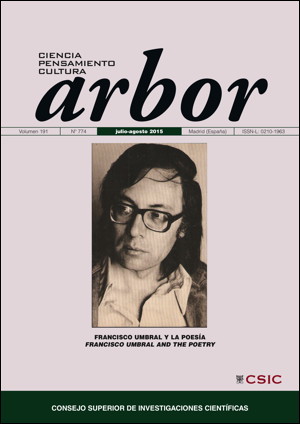Aleixandre’s and Cernuda’s shadows at Francisco Umbral’s poetry
DOI:
https://doi.org/10.3989/arbor.2015.774n4001Keywords:
poetry, influence, metaphors, pessimism, sea, innocence, love, deathAbstract
Francisco Umbral began late as a poet, not publishing his first poetic works until 1981. We can particularly see the influence of two members of Generation of ’27 in his poetry: Vicente Aleixandre and Luis Cernuda, who represent the more formal aspect of their generation, having eschewed the more popular facet. They are characterised by narrative poetry, which is also a feature of Umbral’s poetry. The most notable influence of Aleixandre is the constant use of metaphors. The perspective of “chronic pessimism”, the spleen that we find in his verses, are an influence of Cernuda. This study examines the link between an Aleixandre’s poem, “Hija de la mar”, and a Umbral’s poem, “Herramienta del mar”, and it relates both poems with the characters who live in Cernuda’s poetry and prose fiction. We can also find a link between love and death in the three poets.
Downloads
References
Aleixandre, V. (2005). Poesía Completa (ed. A. Duque Amusco). Madrid: Visor.
Caballé, A. (2004). Francisco Umbral. El frío de una vida. Madrid: Espasa Calpe.
Cernuda, L. (2002). Prosa II (ed. D. Harris y L. Maristany). Madrid: Siruela.
Cernuda, L. (2005). Poesía Completa (ed. D. Harris, D. y L. Maristany). Madrid: Siruela.
Umbral, F. (1994). Las palabras de la tribu. Barcelona: Planeta.
Umbral, F. (2009). Obra poética 1981-2001 (ed. M. García-Posada). Barcelona: Seix Barral.
Published
How to Cite
Issue
Section
License
Copyright (c) 2015 Consejo Superior de Investigaciones Científicas (CSIC)

This work is licensed under a Creative Commons Attribution 4.0 International License.
© CSIC. Manuscripts published in both the printed and online versions of this Journal are the property of Consejo Superior de Investigaciones Científicas, and quoting this source is a requirement for any partial or full reproduction.All contents of this electronic edition, except where otherwise noted, are distributed under a “Creative Commons Attribution 4.0 International” (CC BY 4.0) License. You may read here the basic information and the legal text of the license. The indication of the CC BY 4.0 License must be expressly stated in this way when necessary.
Self-archiving in repositories, personal webpages or similar, of any version other than the published by the Editor, is not allowed.














